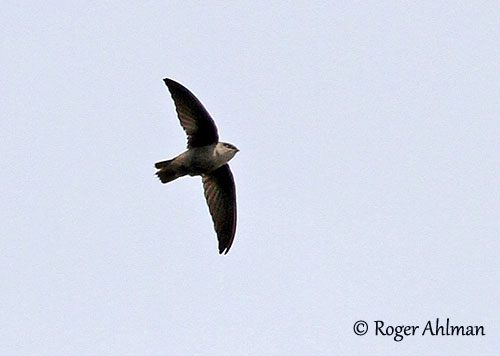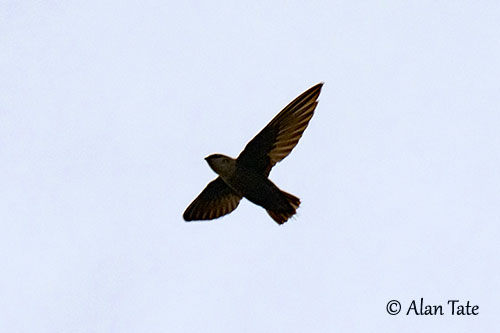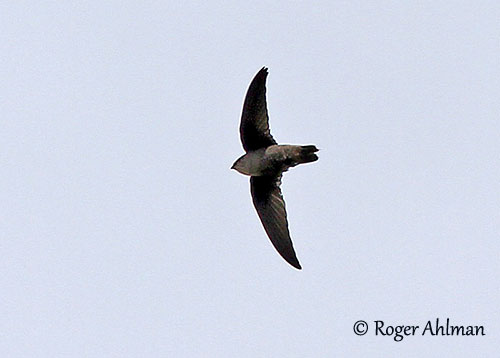
REPRODUCTION OF THIS SPECIES:
The breeding season takes place between mid-May and early July, with some variations according to the range.
The Chimney Swift typically nests in chimneys, but other structures are also used. The nest is placed well down from the opening, usually in shaded area. Both adults build the nest, a half-cup, with twigs glued together with saliva. The nest itself is also glued to the vertical surface.
During the breeding season, the salivary glands of each adult are larger, more than double in size.
The female lays 4-5 / 3-6 white eggs, and both adults share the incubation during 19-21 days. The chicks are fed with regurgitated insects. They are able to climb out of the nest about 20 days after hatching, creeping up the vertical wall. The first flight occurs 30 days after hatching.
The breeding pair is often assisted by an extra-adult helper.
PROTECTION / THREATS / STATUS:
The Chimney Swift is relatively common and widespread throughout the range, but the species is threatened by the lack of nesting and roosting sites caused by logging operations, demolition of old buildings, and especially accessible traditional chimneys. The birds are also vulnerable to harsh weather conditions during the nesting period and hurricanes during migrations.
The North American global population was estimated to number 7,700,000 mature individuals in 2016, and it is slowly declining.
The Chimney Swift is currently classified as Near Threatened.
Fr: Martinet ramoneur
Ang: Chimney Swift
All: Schornsteinsegler
Esp: Vencejo de Chimenea
Ita: Rondone dei camini
Nd: Schoorsteengierzwaluw
Sd: skorstensseglare
Photographers:
Roger Ahlman
Pbase Galleries Peru and Ecuador & My bird pictures on IBC
Alan & Ann Tate
AA Bird Photography
Text by Nicole Bouglouan
Sources:
HANDBOOK OF THE BIRDS OF THE WORLD Vol 5 by Josep del Hoyo-Andrew Elliott-Jordi Sargatal - Lynx Edicions - ISBN: 8487334253
Animal Diversity Web (University of Michigan Museum of Zoology)
All About Birds (Cornell Lab of Ornithology)
The Birds of North America online
Neotropical Birds – Cornell Lab of Ornithology
Wikipedia, the free encyclopaedia
Species at Risk Public Registry
Chimney Swift
Chaetura pelagica
Apodiformes Order – Apodidae Family
INTRODUCTION:
The Chimney Swift typically nests in chimneys, and this behaviour gives the bird its name.
The swifts of genus Chaetura are also named “spinetails” referring to the unusual structure of their rectrices. The bare rachides at the tips are stiffened along the whole length. These features help the bird to cling on vertical surfaces and are used as “crampons”.
The Chimney Swift breeds in the eastern part of North America and winters in NW South America. It feeds on flying insects caught on the wing, and usually forages in small flocks. It lives in the sky, especially over cities and towns.
It comes to earth for breeding, and if they nested formerly in tree cavities, the forest clearance has involved lack of old suitable trees, and the swifts turned to chimneys. However, the deterioration of brick chimneys and the increasing use of chimney caps reduce available nest sites.
The Chimney Swift is currently classified as Near Threatened.

DESCRIPTION OF THE BIRD:
Biometrics:
Length: 12-14 cm
Wingspan: 29-31 cm
Weight: 17-30 g
The Chimney Swift shows fairly uniform dark grey-brown upperparts, with little contrast between rump/uppertail-coverts and rest of upperparts.
The underparts are dark grey-brown too, except the pale grey throat, sometimes white in some individuals.
The short, square tail shows several spines of up to almost 8 mm beyond the tips of the rectrices, forming the distinctive “spines” or “needles” giving the bird the name “spinetail”.
The powerful wings with hooked outer wing and pointed wingtips help the bird to decrease air turbulence during the flight.
The very small black bill has huge gape extending back below the eyes. It allows the bird to snatch insects in flight.
The large dark brown eyes are protected by some black, bristly feathers in front of each eye.
The black legs are typically very short with small but strong feet. The toes have very sharp, curved claws, and are placed with one back and three forwards. The back toe can be moved forwards for better grip on vertical surfaces.
Male and female have similar plumage, but the male is slightly heavier than the female.
The juvenile resembles adults, but it has small white tips to inner flight-feathers.
RANGE:
The Chimney Swift breeds in the eastern part of North America, from S Canada (E from SE Saskatchewan), S to W Texas and Gulf Coast, and occasionally in California and Arizona.
It winters in NW South America in Colombia, E Ecuador, W and E Peru, NW Brazil and N Chile, but the range is still unclear.

HABITAT:
The Chimney Swift lives in the air, but during the breeding season, it is often found near human settlements including cities and towns.
In South America, it frequents irrigated cultivated areas where humans are living. In natural settings, it can be found at the edge of forested rivers, or at the edge of lowland evergreen forests or secondary growth scrub, and over the Andean valleys in Peru and Ecuador. This species may occur up to 2,500 metres of elevation, sometimes higher in S Ecuador.
CALLS AND SONGS: SOUNDS BY XENO-CANTO
The Chimney Swift produces series of short single notes “tsip…tsip…tsip…tsip…” usually followed by twittering descending trills “t-t-rrrr…t-t-rrrr…t-t-rrrr…”
They are very vocal, and especially during the breeding season.
BEHAVIOUR IN THE WILD:
The Chimney Swift feeds exclusively on the wing, pursuing insects and snatching them while flying with widely open gape. It feeds mainly on flying insects including beetles, flies, true bugs and moths. It also catches spiders and other insects by hovering at branches. Flocks may gather at times on swarming insects, especially adult ants.
The Chimney Swift performs aerial courtship displays. Two birds are flying close together, one following the other, gliding with wings help up in V. The aerial displays are usually followed by apparent aerial copulation, but they may also mate at nest-site. This species is monogamous with long-term to life-long pair bonds of about 8-9 years.
The Chimney Swift occurs in North America from April to September. It migrates from late August to late October and from mid-April to mid-May.
This species is vagrant in Bermuda, Bahamas, Galapagos Islands and Greenland, and can be seen occasionally in Britain and Canary Islands.
The flight of the Chimney Swift is fast, with rapid, quivering wingbeats interspersed with long glides.
The American naturalist and ornithologist Roger Tory Peterson described the flying swift as a “cigar with wings”.
The flight is usually very fast and erratic, with numerous rapid changes of direction.
